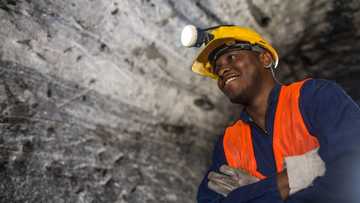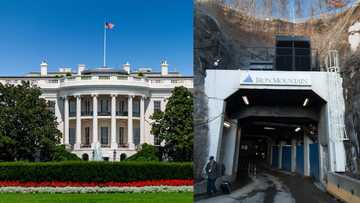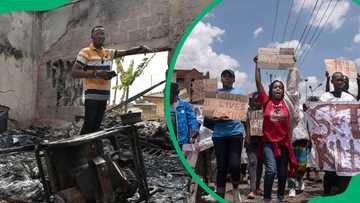Full list of research institutions in South Africa (2024)
New and better ways to approach things are discovered daily through research. A country can easily find solutions to its problems through innovative research, which is why developed and developing nations are heavily invested in such areas. This article looks at research institutions in South Africa and their impact.

Source: Getty Images
TABLE OF CONTENTS
- What are research and development institutions in South Africa?
- Which are the leading research institutions in South Africa?
- 1. Africa Institute of South Africa (AISA)
- 2. Agricultural Research Council (ARC)
- 3. Centre for the Aids Programme of Research in South Africa (CAPRISA)
- 4. Council for Geoscience (CGS)
- 5. Council for Scientific and Industrial Research (CSIR)
- 6. Economic Policy Research Institute (EPRI)
- 7. Hartebeesthoek Radio Astronomy Observatory (HartRAO)
- 8. Human Sciences Research Council (HSRC)
- 9. Institute for Commercial Forestry Research (ICFR)
- 10. Institute for Futures Research (IFR)
- 11. MINTEK
- 12. National Health Laboratory Service (NHLS)
- 13. South African Association for Marine Biological Research (SAAMBR)
- 14. South African Astronomical Observatory (SAAO)
- 15. South African Environmental Observatory Network (SAEON)
- 16. South African Institute for Aquatic Biodiversity (SAIAB)
- 17. South African Institute of International Affairs (SAIIA)
- 18. South African Medical Research Council (SAMRC)
- 19. South Africa's National Energy Development Institute (SANEDI)
- 20. South African Nuclear Energy Corporation (NECSA)
- 21. South African Sugarcane Research Institute (SASRI)
- 22. Water Research Commission (WRC)
- Which is the biggest research centre?
- Which country is best for natural sciences research?
- How do research institutes make money?
- What qualifies a research university?
- Which university has the best research facilities?
South African scientists are constantly working around the clock to come up with ground-breaking innovations. Mzansi has made tremendous strides in the field, although the continent still lags and contributes less than 2% of the world's research.
What are research and development institutions in South Africa?
R&D institutions conduct innovative research to develop new processes or products and improve existing ones. The institutes can specialize in basic research to improve scientific theories or applied research to come up with practical solutions. The study can be in natural science, social science, sociological, or historical.
Which are the leading research institutions in South Africa?
The country has several research facilities dedicated to different fields of study. The following South African research institutes are arranged in alphabetical order.
1. Africa Institute of South Africa (AISA)
AISA is a Science Council founded in 1960 in Pretoria. The institute started as a non-profit organization before being incorporated into South African science councils with support from the Department of Science and Technology. The AISA conducts socio-economic and political research in Africa.
2. Agricultural Research Council (ARC)

Source: Getty Images
ARC is a South African premier science institution established in 1990 in Pretoria. The facility conducts research, develops human capital, and fosters innovation to ensure growth in the country's agricultural sector. ARC is funded by the State and the private sector and has several experimental farms and research branches across agroecological zones of South Africa.
3. Centre for the Aids Programme of Research in South Africa (CAPRISA)
CAPRISA was established in 2002 by five partner institutions, including the University of KZN, the University of Cape Town, the University of Western Cape, the National Institute for Communicable Diseases, and Columbia University in New York. The facility conducts responsive research on HIV, TB and SARS-CoV-2 epidemiology, pathogenesis, and disease prevention and treatment. CAPRISA is a designated Centre of Excellence in HIV prevention for the NRF and the South African Department of Science and Innovation.
4. Council for Geoscience (CGS)
CGS, previously called the Geological Survey of South Africa, was established in 1993 in Silverstone, Pretoria. It is one of the National Science Councils of South Africa responsible for research in the field of geoscience and the provision of specialized geoscientific services. The Council is also the national custodian of radiometric, aeromagnetic, and gravity coverage across the Mzansi.
5. Council for Scientific and Industrial Research (CSIR)

Source: UGC
CSIR is a premier African research and developmental facility established in 1945 by an act of parliament. The Pretoria-based organization is the largest R&D institute in Africa and is responsible for socio-economic growth through innovation.
What areas does CSIR focus on?
To ensure the desired goals are reached, CSIR focuses on nine clusters. They include NextGen Health, Future production: Chemicals, Future production: Manufacturing, Advanced Agri and Food, Defence and Security, NextGen Enterprises and Institutions, Smart Logistics, Future production: Mining, and Smart Places.
6. Economic Policy Research Institute (EPRI)
EPRI is a global organization established in 1994 as a non-profit and independent research facility in Cape Town, South Africa. It is responsible for ensuring governments and their developmental partners design and implement strategies that support equitable economic growth and inclusive social development. The facility specializes in research, capacity building, and policy advisory services to ensure comprehensive and integrated social protection systems.

Read also
2 SA former convicts advocate for education and prison reform as inaugural Global Freedom Fellows
7. Hartebeesthoek Radio Astronomy Observatory (HartRAO)

Source: Getty Images
HartRAO is a National Research Facility established in 1961 by the USA's National Aeronautics and Space Administration (NASA). The institution is located in the west of Johannesburg, Gauteng, South Africa and has been operated by the National Research Foundation (NRF) since 1988. HartRAO's functions post-NASA involve radio astronomy and space geodesy.
8. Human Sciences Research Council (HSRC)
HSRC was founded in 1968 in Pretoria as a statutory research agency. The facility has grown to become the largest dedicated social science and humanities research agency in Africa. HSRC conducts large-scale, policy-relevant, and social-scientific research for the public sector, NGOs, and international development agencies. It also ensures the gap between research, policy, and action is bridged and provides objective information to assess South Africa's progress in achieving its goals.
9. Institute for Commercial Forestry Research (ICFR)

Source: Getty Images
ICFR is a non-government organization founded in 1947 in KwaZulu-Natal. The facility provides project-based research and related services in support of forest management. It offers research capability and solutions to ensure tree improvement and sustainable production. ICFR is privately funded by direct contributions from various companies.
10. Institute for Futures Research (IFR)
IFR was established in 1975 as a research facility of the University of Stellenbosch Business School. It specializes in futurology, and its research focuses on energy futures, socio-political studies, technology foresight, applied demographics, long-term economic research, and business futuristics. It helps clients acquire strategic foresight to make better long-range decisions, sense opportunities, and mitigate risks in time. IFR is the first and only Futures Institute established in Africa.
11. MINTEK
MINTEK is a national mineral research organization established in 1934 in Randburg, Gauteng. The facility is one of the world's largest providers of minerals processing and metallurgical engineering products and services to industries across the globe. MINTEK provides service test work, process development and innovative products using R&D expertise supported by modern laboratories, pilot plants and workshops, and extensive intellectual capital.
12. National Health Laboratory Service (NHLS)

Source: Getty Images
The NHLS is a national public entry established in 2001 in Johannesburg and has a presence in all of South Africa's nine provinces. The facility came into existence through the amalgamation of the South African Institute for Medical Research (SAIMR), the National Institute for Virology, and the National Center for Occupational Health. NHLS is responsible for providing quality, affordable, and sustainable health laboratory services, training, and research.
13. South African Association for Marine Biological Research (SAAMBR)
SAAMBR is a non-government centre founded in 1951 in Durban, KwaZulu, to conduct marine biological and conservation research in the Western Indian Ocean. The facility has three divisions: the Oceanographic Research Insitute (ORI), uShaka Sea World (Aquarium), and the uShaka Sea World Education Centre. SAAMBR is a member of the International Union for Conservation of Nature (IUCN).
14. South African Astronomical Observatory (SAAO)
SAAO is a South African national centre for optical and infrared astronomy established in 1972 in the Northern Cape. The facility is operated by the National Research Foundation of South Africa, and its primary function is to carry out research in astronomy and astrophysics. SAAO is headquartered in Cape Town, but its primary telescopes are in Sutherland, Northern Cape.
15. South African Environmental Observatory Network (SAEON)

Source: UGC
SAEON was established in 2002 in Pretoria to perform Long-Term Ecological Research (LTER) in the country and surrounding oceans. The facility is operated by the National Research Foundation and has three focus areas, including education outreach, data management, and environmental observation. SAEON is composed of a research network that covers major terrestrial and marine ecosystems in South Africa. The facility's activities are funded by the Department of Science and Innovation.
16. South African Institute for Aquatic Biodiversity (SAIAB)
SAIAB is a National Research Facility founded in 1969 in Grahamstown, Eastern Cape. It is operated by the National Research Foundation and serves as a primary scientific resource for understanding the biodiversity and functioning of significant aquatic ecosystems. Southern Africa is ideally situated with both freshwater and marine biogeographical boundaries hence best suited to monitor and document climate change.
17. South African Institute of International Affairs (SAIIA)
SAIIA is an independent public policy think tank established in 1934 in Johannesburg, Gauteng. The facility is South Africa's premier research institute on international issues and is responsible for advancing a well-governed, peaceful, economically sustainable, and globally engaged Africa.
18. South African Medical Research Council (SAMRC)

Source: UGC
SAMRC is a South African parastatal medical research facility established in 1969 in Cape Town. Its primary mandate is to promote the improvement of the health and quality of life of Mzansi citizens through research, development, and technology transfer. SAMRC's research focuses on the ten highest causes of mortality in the country, including women's health, alcohol and substance abuse, chronic ailments, HIV, TB, and cardiovascular diseases.
19. South Africa's National Energy Development Institute (SANEDI)
In 2011, SANEDI was established as a successor to the previously created South African National Energy Research Institute (SANERI) and the National Energy Efficient Agency. The facility's primary responsibility is to direct, monitor and conduct energy research and development, promote innovation, and undertake measures to promote energy efficiency throughout the economy. It is also mandated to develop innovative, integrated, clean energy and resource-efficient solutions to ensure growth and prosperity.
20. South African Nuclear Energy Corporation (NECSA)

Source: UGC
NECSA, previously called the Atomic Energy Corporation of South Africa, was established in 1999 as a public company by the Republic of South Africa Nuclear Energy and is wholly owned by the State. The facility is responsible for R&D in the field of nuclear energy and radiation sciences. It also oversees the processing of source material, including uranium enrichment and working with other local and overseas institutions on nuclear matters in South Africa.
21. South African Sugarcane Research Institute (SASRI)
SASRI was established in 1925 in Durban and is a provision of the South African Sugar Association (SASA). It is an agricultural research institute with the responsibility to ensure sustainability of the local sugar industry. Research at SASRI is divided into four multidisciplinary programmes, including variety improvement, crop protection, crop performance & management, and systems design & optimization.
22. Water Research Commission (WRC)

Source: Getty Images
WRC was established in 1971 by the Water Research Act following a period of extreme water shortage. The research and knowledge hub is responsible for providing information that drives innovation in the country's water sector.
Which is the biggest research centre?
The National Institutes of Health (NIH) in the United States is the largest research centre in the world. NIH is part of the United States Department of Health and Human Services and is responsible for the country's medical research.
Which country is best for natural sciences research?
The United States has the highest-quality natural sciences research that is boosted by the country's top-performing institutions like Harvard, Stanford, MIT, and the National Institutes of Health (NIH). It is closely followed by China, which continues to make huge advancements.
How do research institutes make money?
Research institutes get money from corporations and governments. They are non-profit organizations hence all the funding is invested in research.
What qualifies a research university?

Source: Getty Images
Research universities are committed to research which is done for public benefit. The facilities often receive funding from governments, and they can be public or private research universities.
Which university has the best research facilities?
Massachusetts Institute of Technology (MIT) is regarded as the best research university in the world. The university's research is conducted in 30 departments and through collaborations with organizations like the MIT Lincoln Library, Clinical Research Center, Howard Hughes Medical Institute, Whitehead Institute for Biomedical Research, and Center for Computational Engineering. Undergraduates are also involved in research through the Undergraduate Research Opportunities Program (UROP).
Research institutions in South Africa are some of the best in the continent. They continue to make various sectors of the country better and sustainable for economic, social, scientific, and political growth.
READ ALSO: Top scarce skills in South Africa according to the DHA
Briefly.co.za highlighted critical skills in South Africa as reported by the Department of Home Affairs (DHA). Such skills are deemed critical due to their importance to the country's economy.
The scarce skills form the basis for handing out critical skills work visas to foreigners interested in working in the country. They are also some of the highest-paying jobs and sometimes require extensive training.
Source: Briefly News












